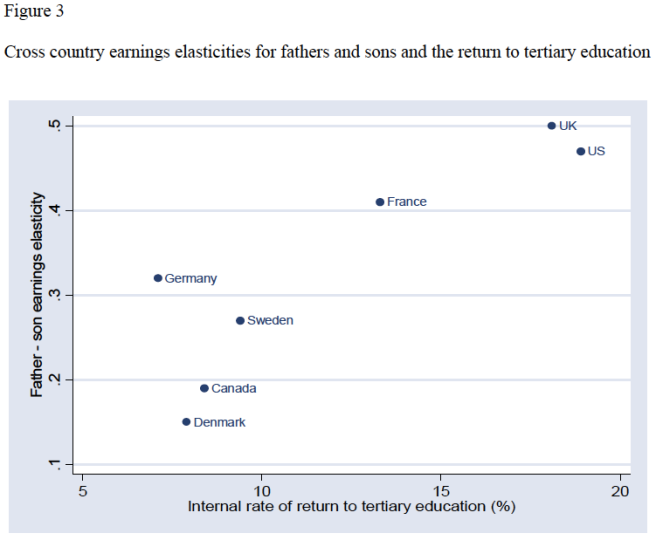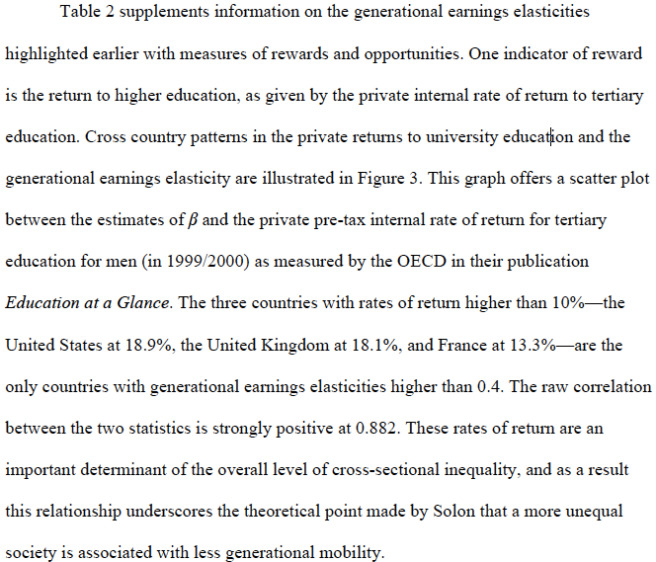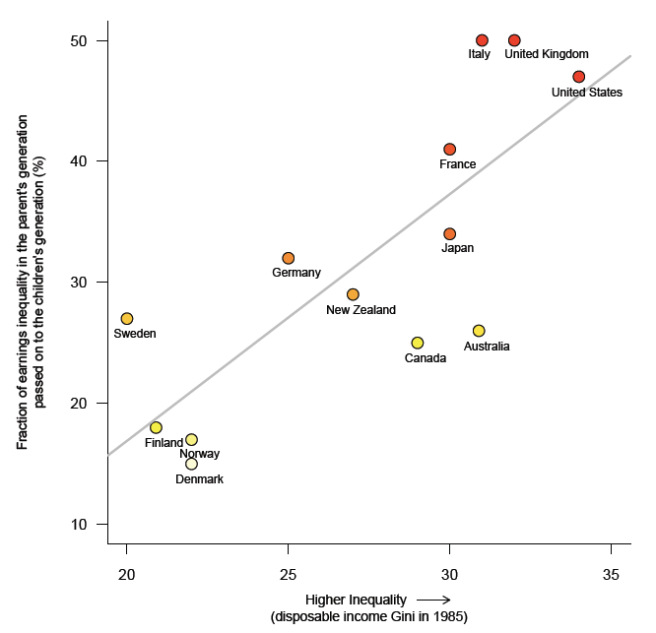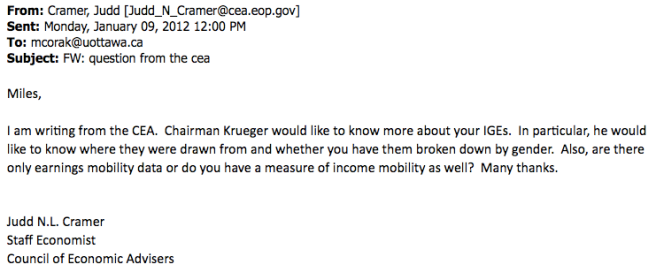On January 4th, 2012 The New York Times published an article called “Harder for Americans to Rise from Lower Rungs.” I had spent a considerable amount of time during the New Year’s holidays talking with Jason DeParle about the comparative literature on intergenerational income mobility, and was pleased to see his article on the front page.
So pleased that I emailed Alan Krueger, the Princeton University economist who at the time was the Chairman of the Council of Economic Advisors, to draw his attention to it, though I don’t know why I imagined that Krueger and his staff in the White House would not be reading The Times.
That is how “The Great Gatsby Curve” was born.
My email included a link to a blog post I wrote in the wake of the Occupy Wall Street protests. The post began “There is nothing wrong with inequality … until it starts limiting opportunity.” I suggested to Krueger that he check it out if he ever needed “a graph depicting the relationship between inequality and intergenerational mobility.”
And that pretty well sums up my role in naming the graph.
The first time I heard it called “The Great Gatsby Curve” was when I was watching the live stream of Krueger’s speech—“The Rise and Consequences of Inequality“—on January 12th, 2012 at the Center for American Progress.
Krueger recently told me that his speech was intended to inform the President’s upcoming State of the Union address. It is unusual for a White House official to be given permission to speak during a period so close to the SOTU, so clearly there was interest in this topic, and Krueger knew the President’s speechwriters would find the material valuable.
At around that time, I received an email from Judd Cramer—one of the White House staffers helping Krueger with his speech—which I instinctively started to delete as spam since it came from “The White House.” Fortunately, I didn’t … after all, no spammer knows you well enough to ask about your “IGEs”.
Responding to this request was my only other involvement in the speech.
In a recent email exchange Krueger told me that the
speech was well covered in part because I was the only Obama Administration official speaking publicly so close to the SOTU, and in part because of the novelty and comprehensiveness of the analysis contained in the speech.
 He also stressed that labels are important, something he realized from his experience with David Card in naming their 1995 book on the impact of minimum wages: “F. Scott Fitzgerald’s working title was “Among the Ash Heaps and Millionaires.” I venture the hypothesis that had he stuck with that title no one would recall Jay Gatsby today, and the Great Gatsby curve would have been christened with a different name.”
He also stressed that labels are important, something he realized from his experience with David Card in naming their 1995 book on the impact of minimum wages: “F. Scott Fitzgerald’s working title was “Among the Ash Heaps and Millionaires.” I venture the hypothesis that had he stuck with that title no one would recall Jay Gatsby today, and the Great Gatsby curve would have been christened with a different name.”
I did not give the curve its name, and if it had been up to me to give it a catchy title I probably would have liked—with the benefit of hindsight—to call it the “The Galton Gini Curve,” the vertical axis of the graph paying homage to Francis Galton, who developed the regression to the mean model used to estimate the intergenerational income elasticity, and the horizontal to Corrado Gini, the Italian Statistician who derived the famous indicator of income inequality. This would probably have been a sure loser in the sweepstakes that actually took place.
My understanding of how the name came about is based on conversations with Krueger, a brief discussion with Jason Furman, and from an email exchange with Cramer (who is now with the department of economics at Harvard University).
Here’s how Cramer related the story to me in responding to an email I sent him in September 2016:
The short version of the story is: Reid Stevens and I were working with Alan for his speech at the Center for American Progress about the middle class. We got data from your paper and elsewhere and made the figure at Alan’s direction. Alan wanted a name for it; something that spoke about the rich staying rich, etc. We were in a meeting in the chairman’s conference room and he asked us to go brainstorm names. We went back to the room where many of the junior staffers sat together, we called it the bullpen, and after we explained the curve to all the staffers, we each put down one suggestion. Reid may remember the also-rans better than I do but I wrote down the Great Gatsby curve because of Gatsby’s trouble trying to jump social classes in spite of his money. A few of the other staffers teased me for my suggestion. None of the others were too great in my opinion; I remember a lot of the other names playing on white picket fences/silver spoons in their names.We then walked the list back over to Alan and his chief of staff, David Vandivier. Alan read all the names and chose the Great Gatsby curve. During that time in DC, Alan was in the business of promoting New Jersey wines and he gave Reid and me a bottle for our help with the speech that went well a few days later.I think that touches on the major points.
Brendan Greeley, in an article published in BloombergBusinessweek called “The Great Gatsby Curve: How Inequality Became a Household Word,” offers an outline of this story, but with the broader objective of illustrating how the discussion of inequality and mobility moved from the academic world to be the center-piece of public policy discussion, and in particular to find its way in President Obama’s December 4th, 2013 speech on economic mobility.
To the best of my knowledge, I was the first to publish a version of the curve, in an article that was circulating in 2004, and eventually appeared as Figure 3 in a 2006 publication that was also released as IZA Discussion paper 1993. But an idea like this grows in one’s mind through a conversation with colleagues, and the literature. For example, the opening paragraphs of a 1997 paper by Anders Björklund and Markus Jäntti published in the American Economic Review includes the following:
Our interest in a comparison of intergenerational income correlation between Sweden and the United States is motivated, in part, by the question whether the extent of cross-sectional inequality and intergenerational inequality are independent of each other. Is it possible that Sweden, which has less cross-sectional inequality, also has more intergenerational mobility?
My version of the relationship sprang out of a comprehensive literature review of these estimates put together just after I had sent off the page proofs of a book I had edited on comparisons of intergenerational mobility between North America and Europe, which included a chapter—a theoretical chapter—by Gary Solon, the economist who repeatedly made important contributions to this literature during the 1990s.
This inspired me to produce my version of the curve. In my mind Solon is the grandfather of The Great Gatsby Curve, and his thinking was directly inspired by two of the most influential theoretical papers in this field, both co-authored by Gary Becker and Nigel Tomes. I summarize these roots in a January 17th, 2012 post called “The Economics of the Great Gatsby Curve,” where you can also download a copy of Solon’s chapter.


Others have also drawn the curve, and I believe Dan Andrews and Andrew Leigh in a 2007 article and Jo Blanden in a 2011 article were the first to independently put the Gini coefficient on the horizontal axis. You can also see this formulation in the opening chapter of a 2012 Russell Sage Foundation book called From Parents to Children: The Intergenerational Transmission of Advantage by John Ermisch, Markus Jäntti, Timothy Smeeding, and James Wilson, who also make reference to a 2009 paper by Jäntti and Björklund.
But this is a line of thinking that clearly goes back many years. In 1931, around the time F. Scott Fitzgerald wrote The Great Gatsby, R.H. Tawney—the great British historian—published a book called Equality. He clearly felt that equality of opportunity can only be advanced in an environment of relative equality:
It is true, of course, that a community must draw on a stream of fresh talent, in order to avoid stagnation, and that, unless individuals of ability can turn their powers to account, they are embittered by a sense of defeat and frustration. The existence of opportunities to move from point to point on an economic scale, and to mount from humble origins to success and affluence, is a condition, therefore, both of social wellbeing and of individual happiness, and impediments which deny them to some, while lavishing them on others, are injurious to both. But opportunities to “rise” are not a substitute for a large measure of practical equality, nor do they make immaterial the existence of sharp disparities of income and social condition. On the contrary, it is only the presence of a high degree of practical equality which can diffuse and generalize opportunities to rise. The existence of such opportunities in fact, and not merely in form, depends, not only upon an open road, but upon an equal start. It is precisely, of course, when capacity is aided by a high level of general wellbeing in the milieu surrounding it, that its ascent is most likely to be regular and rapid, rather than fitful and intermittent.
Whatever you think of the name—and I have had a number of academic colleagues joke about it not making any sense—it has been an effective communication device to raise important issues to a concerned public. It seems to me, a lesson from this is that an explicit communication strategy should be a part of the agenda for anyone doing good, solid, policy-relevant research.
[ Other researchers working in this area will surely have their perspective on this issue, so I would invite any feedback, corrections, or other information to help fill out the story. Feel free to share your thoughts in the comment section. If you have used The Great Gatsby Curve in your research, tell us how, and include a link to your work.
The Curve has indeed been used and studied by many, but if you want more information on how to interpret The Great Gatsby Curve, and the implications to be drawn for public policy, you might find my article “Income Inequality, Equality of Opportunity, and Intergenerational Mobility,” published in the Summer 2013 issue of the Journal of Economic Perspectives, helpful.
This post is meant to offer background to a very brief discussion of the topic in my paper ” ‘Inequality is the root of social evil,’ or maybe not? Two stories about inequality and public policy”, which is published in the December 2016 issue of Canadian Public Policy, and also to respond to the many questions I get about the origin of The Great Gatsby Curve. ]



An inspiring story of intellectual honesty. Thank you!